When we look up at the night sky, we often see Earth’s companion—the Moon. It glows brightly against the darkness, inspiring countless stories, scientific discoveries, and human curiosity. But is Earth’s moon the biggest moon in the solar system? Not even close! Our solar system is home to over 200 moons, and some are truly enormous—larger than even some planets.
In this journey through space, we’ll explore the largest moons in our solar system, comparing their sizes, unique features, and the fascinating worlds they represent.
- What is the largest moon in the Solar System?
- Is Titan the biggest moon?
- Is Earth’s Moon is the biggest?
- Top 10 biggest moons in the Solar System
- How these moons are compared to Earth?
- Moon with a retrograde orbit
- Let’s place all these moons
- How these moons were formed?
- Past, present, and future missions
- Could these moons harbor life?
What is the largest moon in the Solar System?
If you’ve ever wondered what’s the biggest moon in the solar system, the answer is Ganymede. This enormous moon orbits around Jupiter, the largest planet in our solar system. Discovered in 1610 by the famous astronomer Galileo Galilei, Ganymede is truly a giant among moons.
How big is the biggest moon?
Ganymede’s size is impressive—with a diameter of 5,268 kilometers (3,273 miles), it’s even larger than the planet Mercury! To put this in perspective, if you placed Ganymede next to Earth, it would be about 41% of our planet’s size. That means if you could somehow place Ganymede on Earth, it would stretch roughly from New York to Denver!
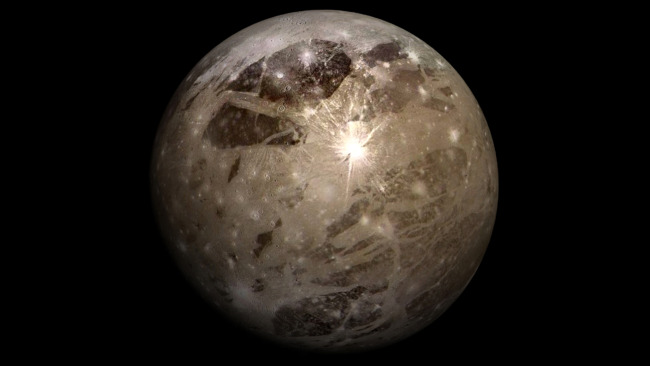
When we talk about the largest moon in the solar system by mass, Ganymede also takes first place. It weighs approximately 1.48 × 10^23 kilograms, which is about 2.5% of Earth’s mass. That might not sound like much, but remember—this is just a moon!
The biggest moon in the solar system orbits Jupiter, which seems fitting since Jupiter is also the largest planet. Jupiter is like a mini solar system of its own, with at least 95 known moons. Among these, four stand out as particularly large—the Galilean moons: Io, Europa, Ganymede, and Callisto, all discovered by Galileo Galilei.
Which planet has the biggest moon?
Jupiter has the honor of hosting Ganymede, the largest moon in our solar system. This gas giant planet seems to collect massive moons—in fact, three of Jupiter’s moons (Ganymede, Callisto, and Io) make it into the top five largest moons list.
Is Titan the biggest moon?
Many people wonder if Titan, Saturn’s famous moon with its thick atmosphere, is the biggest moon in the solar system. Titan is indeed impressive, but it actually ranks as the second biggest moon in the solar system, after Ganymede.
What is the second biggest moon?
Titan, orbiting the ringed planet Saturn, holds the title of second biggest moon in the solar system. With a diameter of 5,150 kilometers (3,200 miles), it’s just slightly smaller than Ganymede. What makes Titan special, however, is its thick atmosphere—the only moon in our solar system with a substantial atmosphere, even denser than Earth’s!
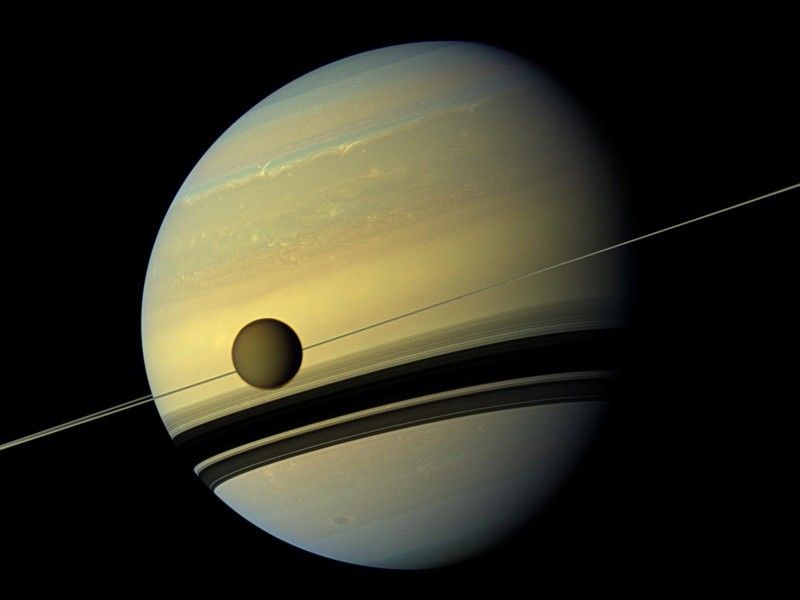
Scientists are particularly interested in Titan because its surface has lakes, rivers, and seas—not of water, but of liquid methane and ethane. Imagine rain made of natural gas falling onto mountains of ice! Titan’s unique environment makes it one of the most Earth-like places in our solar system, despite its freezing temperature of about -179°C (-290°F).
Is Earth’s Moon is the biggest?
Many people naturally wonder: Is our moon the biggest moon in the solar system? After all, it appears so large in our night sky. However, our Moon (often called Luna by scientists to distinguish it from other moons) is actually only the fifth largest moon in the solar system.
No, our Moon is not the biggest moon in the solar system. With a diameter of 3,474 kilometers (2,159 miles), Earth’s Moon is considerably smaller than Ganymede, Titan, Callisto, and Io. However, compared to Earth, our Moon is quite large relative to its parent planet—about 27% of Earth’s diameter. This is an unusually high ratio; most moons are much smaller compared to their planets.
Our Moon may not be the biggest, but it plays a crucial role in making Earth habitable. It stabilizes Earth’s axial tilt, which gives us consistent seasons, and creates tides that may have been important for the development of life in early Earth’s oceans.
Top 10 biggest moons in the Solar System
Let’s explore the top 10 biggest moons in the solar system, ranked by diameter:
- Ganymede (Jupiter): 5,268 km – The undisputed champion and largest moon in the solar system
- Titan (Saturn): 5,150 km – Famous for its thick atmosphere and liquid methane lakes
- Callisto (Jupiter): 4,821 km – The most heavily cratered object in the solar system
- Io (Jupiter): 3,643 km – The most volcanically active body in our solar system
- Earth’s Moon: 3,474 km – Our closest celestial neighbor
- Europa (Jupiter): 3,122 km – Known for its smooth ice surface and subsurface ocean
- Triton (Neptune): 2,707 km – The largest moon of Neptune, orbiting backward
- Titania (Uranus): 1,578 km – The largest moon of Uranus
- Rhea (Saturn): 1,527 km – Saturn’s second-largest moon
- Oberon (Uranus): 1,523 km – The second-largest moon of Uranus
Each of these moons is a unique world with its own geography, composition, and mysteries waiting to be explored.
How these moons are compared to Earth?
When comparing the biggest moons in solar system compared to Earth, even the largest—Ganymede—is still much smaller than our planet. Earth has a diameter of about 12,742 kilometers (7,918 miles), making it more than twice the size of Ganymede.
To visualize the biggest moon in the solar system compared to Earth, imagine placing Ganymede next to our planet. Ganymede would be about 41% of Earth’s diameter. While this is smaller than Earth, it’s still impressively large for a moon—larger than the planet Mercury and nearly 2.5 times the size of Pluto!
The largest moon in the solar system compared to Earth would look like a smaller companion, but still massive compared to most other moons. If you could stand on Ganymede’s surface, you would experience only about 14% of Earth’s gravity due to Ganymede’s lower density and mass.
Moon with a retrograde orbit
Among the largest moons, Triton—Neptune’s largest moon—stands out for a special reason. It is the largest moon in the solar system with a retrograde orbit, meaning it orbits in the opposite direction to Neptune’s rotation. This unusual backward motion suggests that Triton wasn’t always Neptune’s moon but was likely captured from elsewhere in the solar system, possibly from the Kuiper Belt (the region where Pluto orbits).
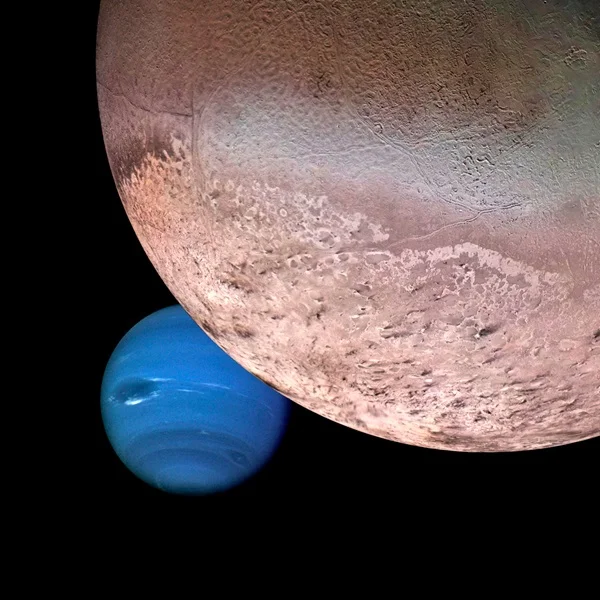
Triton is the seventh-largest moon overall, with a diameter of 2,707 kilometers (1,682 miles). Its surface temperature is about -235°C (-391°F), making it one of the coldest places in our solar system. Despite this extreme cold, Triton shows signs of geological activity, including nitrogen geysers that erupt from its icy surface.
Let’s place all these moons
We’ve already learned that Ganymede is the champion, but what are the biggest moons in the solar system beyond the top few? Let’s examine some fascinating details about these worlds:
The winner: Ganymede
Ganymede isn’t just big—it’s fascinating. This giant moon has its own magnetic field (the only moon known to have one), suggesting a molten iron core. Its surface features dark and light regions, with older, heavily cratered dark terrain and younger, grooved, lighter terrain that suggests past geological activity.
Scientists believe Ganymede may hide a subsurface ocean beneath its icy crust—potentially containing more water than all of Earth’s oceans combined!
Second place: Titan
As the second-largest moon and the only one with a thick atmosphere, Titan is like an early Earth frozen in time. Its atmospheric pressure is about 1.5 times that of Earth’s, though composed mainly of nitrogen with clouds of methane and ethane.
Titan’s surface, hidden from view until the Cassini-Huygens mission pierced through its hazy atmosphere, reveals a world with mountains of ice, dunes made of hydrocarbon particles, and lakes of liquid methane and ethane. Some scientists speculate that life might exist there—though very different from life on Earth, perhaps based on methane rather than water.
Third place: Callisto
Jupiter’s moon Callisto is the third-largest moon in the solar system and the most heavily cratered object we know. Unlike its neighboring moons that show signs of geological activity, Callisto appears to be geologically dead—its surface hasn’t changed much in billions of years, making it a time capsule from the early solar system.
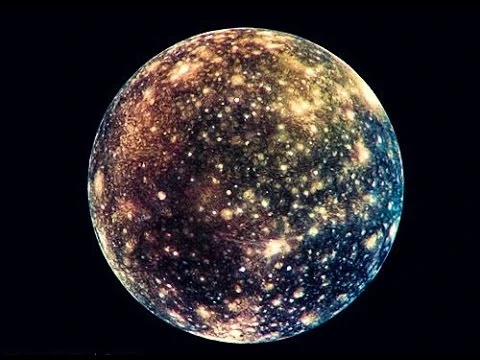
Callisto is interesting to scientists because it may also have a subsurface ocean and, unlike Europa and Ganymede, its ocean would be deeply buried beneath a thick crust of ice and rock.
How these moons were formed?
Understanding how the largest moon in our solar system formed helps us comprehend the solar system’s history. Scientists believe that most large moons formed in one of three ways:
- Formation alongside their planet: Similar to how planets formed from the solar nebula, some moons likely formed from the disc of gas and dust that surrounded young planets. This is probably how Jupiter’s large moons formed.
- Giant impact: Earth’s Moon likely formed when a Mars-sized body collided with early Earth, ejecting material that eventually coalesced into our Moon.
- Capture: Some moons, like Neptune’s Triton with its retrograde orbit, were likely independent objects captured by their planet’s gravity.
The largest moons in our solar system provide valuable information about how planets and their satellites form and evolve.
Past, present, and future missions
Scientists have sent several missions to study the largest moon in the solar system and its companions:
- Pioneer and Voyager missions: These flyby missions in the 1970s and 1980s gave us our first close looks at the giant moons of Jupiter, Saturn, Uranus, and Neptune.
- Galileo mission: This spacecraft orbited Jupiter from 1995 to 2003, studying Ganymede and the other Galilean moons in detail.
- Cassini-Huygens mission: Orbiting Saturn from 2004 to 2017, this mission included a lander that descended to Titan’s surface—the only landing ever accomplished in the outer solar system.
Future missions include:
- Europa Clipper: NASA’s mission scheduled to launch in 2024 will study Jupiter’s moon Europa.
- Dragonfly: Set to launch in 2027, this NASA mission will send a drone-like rotorcraft to explore Titan’s surface.
- JUICE (JUpiter ICy moons Explorer): This European Space Agency mission launched in 2023 will study Ganymede, Callisto, and Europa.
These missions will help answer questions about the potential for life on these worlds, especially those with subsurface oceans like Europa and Ganymede.
Could these moons harbor life?
One of the most exciting questions about the largest moons in our solar system is whether they might harbor life. Several of the largest moons have characteristics that make them potentially habitable:
- Europa: Its subsurface ocean contains more water than all of Earth’s oceans combined, protected from radiation by an icy shell.
- Ganymede: Similar to Europa, it likely has a vast subsurface ocean.
- Titan: Though extremely cold, its lakes of liquid methane and complex organic chemistry could potentially support forms of life very different from Earth’s.
- Enceladus: Though smaller (504 km diameter), this Saturn moon has geysers ejecting water from a subsurface ocean, making it another promising location.
Scientists are particularly interested in these “ocean worlds” because on Earth, wherever we find water, we find life. Could the same be true elsewhere in our solar system?
Check out our awesome INTERACTIVE MOON SIZE COMPARISON
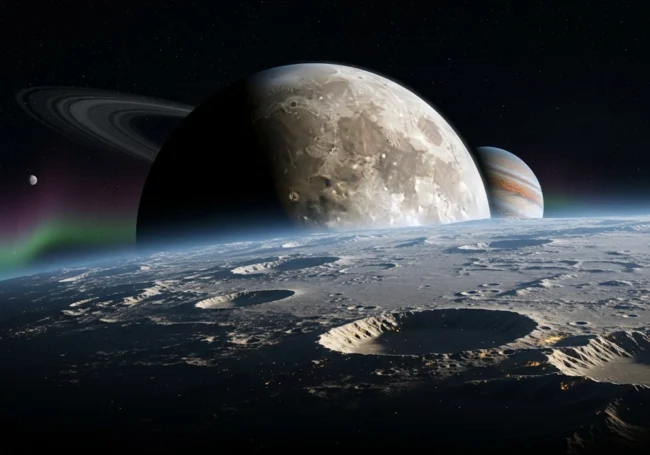
Leave a Reply